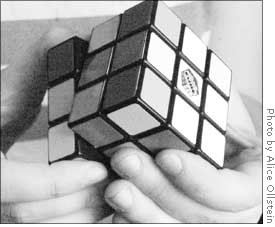
| << Front page | Features | March 9, 2007 |
Learning to Twist and Turn
 |
||
| Twist and Shout: The ExCo is not new to Oberlin, yet it has attracted many students this semester. | ||
If LU’R’UL’U’RU2 means nothing to you, you have yet to try Fall ’06 graduate Zach Tesler’s Rubik’s Cube ExCo, which looks to turn 24 Obie novices into cube masters.
The class, split up into two sections for more intimate teaching, meets weekly in King. Cube in hand, students gather and memorize formulas given to them by Tesler, who circulates the room and helps those who struggle. Comments such as, “She has the gift!” and “The cube speaks to him,” frequently float around the laid-back, friendly atmosphere.
While some students brought the beat-up, peeling Rubik’s Cubes they have played with since childhood, so many rushed to Ben Franklin to buy one there that the store ran out and had to call for an extra shipment — a situation that has arisen each of the two other times Tesler has taught the ExCo.
Tesler has devoted himself to teaching the ways of the cube because of his passion for it.
“It’s a random skill that people like to show off. The cube also teaches patience, hand-eye coordination, color recognition,” he said.
He divulged a secret about its true nature.
“It’s really not very hard. You could learn it in a day or two. The sad reality is that once you know how to do it, it’s really simple and stupid. But it still impresses people,” he said.
College first-year Emily Brunsten has found this to be true.
“A friend came up to me after watching me solve the cube, saying ‘Wow, I can’t believe you can solve that.’ I shouldn’t have told her I was in the ExCo because she thought I was a genius,” she said.
The class midterm will be solving the cube, while the final will consist of a special project, which can range from inventing new formulas to solving the four-by-four or five-by-five Rubik’s options.
Telser’s own cube odyssey began many years ago.
“I was really bored one weekend in high school, so I taught myself. Then, when I didn’t have a Winter Term project freshman year, I decided to do an in-depth study of the Rubik’s Cube. I learned four different ways to solve it,” he said.
Now a part of his life, cubing has “also become an OCD habit” for Tesler.
“If I see one that’s not solved I can’t help myself. I also do it while I’m watching TV, since I don’t have to really look anymore,” he said.
The first time he taught the class for credit, he stuck to a strict syllabus that tried to get everyone cubing at the same rate. Now, after graduating in December, he teaches “just for fun” and allows for a more flexible class where all the students learns at their own speed. Speaking of speed, Tesler can complete the puzzle in about 50 seconds.
He said that although he could incorporate the “very boring” history of the Rubik’s cube into his class, he has decided to focus only on getting his students to solve the puzzle.
He feels pride for the Rubik’s fever he’s started on campus.
“I get excited when I see someone sitting with a cube in Decafé. I know I’m making a difference in some small way,” he said.
About us
Subscriptions
Advertising